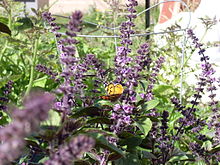- African blue basil
-
African blue basil Scientific classification Kingdom: Plantae (unranked): Angiosperms (unranked): Eudicots (unranked): Asterids Order: Lamiales Family: Lamiaceae Genus: Ocimum African blue basil Details Hybrid parentage Ocimum kilimandscharicum × Ocimum basilicum 'Dark Opal' Origin Peter Borchard, Companion Plants, Athens, Ohio, 1983[1] African blue basil (Ocimum kilimandscharicum × basilicum 'Dark Opal') is one of a few types of basil that is perennial. It is a sterile hybrid of two other breeds of basil, unable to produce seeds of its own, and is propagated by cuttings.[1]
This particular breed of basil has a strong camphor scent, inherited from Ocimum kilimandscharicum (camphor basil),[2] its East African parent.[1] The concentration of camphor is 22% (compared with 61% for O. kilimandscharicum). The concentration of the other major aroma compounds, linalool (55%), and 1,8-cineole (15%) is comparable to many basil cultivars.[3]
Although the combination of a perennial plant with the scent and flavor of sweet basil would seem to make it a very desirable culinary variety, the high camphor content can interfere with its use in cooking. It is, however, an attractive ornamental.
The leaves of African blue basil start out purple when young, only growing green as the given leaf grows to its full size, and even then retaining purple veins. Based on other purple basils, the color is from anthocyanins, especially cyanidin-3-(di-p-coumarylglucoside)-5-glucoside, but also other cyanidin-based and peonidin-based compounds.[3]
It blooms profusely like an annual, but being sterile can never go to seed. It's also taller than many basil cultivars.
See also
References
- ^ a b c Pam Peirce, Special to The Chronicle (July 23, 2005). "PLANT OF THE WEEK: African blue basil; There's a new basil on the (foggy San Francisco) block". San Francisco Chronicle: pp. F–7. http://www.sfgate.com/cgi-bin/article.cgi?file=/chronicle/archive/2005/07/23/HOG7FDQRSK1.DTL.
- ^ "Ocimum kilimandscharicum Baker ex Gürke". GRIN. http://www.ars-grin.gov/cgi-bin/npgs/html/taxon.pl?25484. Gives as its source Econ Bot 28:63 (1974).
- ^ a b J. Janick (ed.), James E. Simon, Mario R. Morales, Winthrop B. Phippen, Roberto Fontes Vieira, and Zhigang Hao, "Basil: A Source of Aroma Compounds and a Popular Culinary and Ornamental Herb", reprinted from: Perspectives on new crops and new uses (1999), ASHS Press, Alexandria, VA, ISBN 978-0-9615027-0-6.
Categories:- Herbs
Wikimedia Foundation. 2010.

